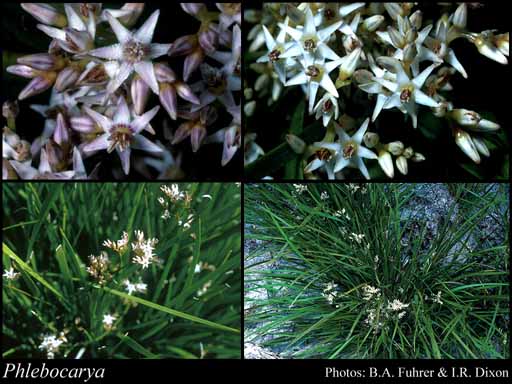- Reference
- Prodr.Fl.Nov.Holland. 301 (1810)
- Name Status
- Current

Scientific Description
Family Haemodoraceae.
Habit and leaf form. Herbs (tufted); with coloured juice, or non-laticiferous and without coloured juice. Perennial. Leaves basal. Plants with a basal concentration of leaves (leaves all radical); rhizomatous (short, rootstock not red internally). Rhizome and root tissues brightly red-pigmented, or not red-pigmented. Mesophytic, or xerophytic. Leaves medium-sized to large; alternate; distichous; leathery; sessile; sheathing. Leaf sheaths with free margins. Leaves edgewise to the stem, or with ‘normal’ orientation; simple; epulvinate. Leaf blades entire; flat, or solid; linear (or ensiform); linear; parallel-veined; sheathing. Leaves without stipules. Leaf blade margins entire (ciliate). Leaves with a persistent basal meristem, and basipetal development. Vernation conduplicate. Leaf anatomy. Guard-cells not ‘grass type’. Hairs present (sparsely to very densely strigose on surfaces), or absent. Extra-floral nectaries absent. Stem anatomy. Secondary thickening absent.
Reproductive type, pollination. Fertile flowers hermaphrodite. Unisexual flowers absent. Plants hermaphrodite. Floral nectaries present. Nectar secretion from the gynoecium (via septal nectaries). Entomophilous, or ornithophilous, or pollinated by unusual means.
Inflorescence and flower features. Flowers aggregated in ‘inflorescences’; in cymes, or in panicles. The terminal inflorescence unit cymose, or racemose. Inflorescences scapiflorous; terminal; scape slender simple or forked, shorter than the leaves, bracteate; panicle cymosely branched, cyme compact or loose. Flowers pedicellate; bracteate; ebracteolate; regular; 3 merous; cyclic; tricyclic, or tetracyclic. Perianth of ‘tepals’; 6 (in 2 whorls); 1 -whorled; isomerous; petaloid; similar in the two whorls; white, or cream, or blue (bluish). Androecial members definite in number. Androecium 6. Androecial members adnate; all equal; free of one another; 2 -whorled. Androecium exclusively of fertile stamens. Stamens 6; all more or less similar in shape; diplostemonous; at the base of the perianth; alterniperianthial. Filaments appendiculate, or not appendiculate. Anthers basifixed; versatile, or non-versatile; dehiscing via longitudinal slits; introrse; unappendaged, or appendaged (apically, from the connective). Gynoecium 3 carpelled. The pistil 3 celled. Gynoecium syncarpous; eu-syncarpous; inferior. Ovary plurilocular; 3 locular (obscure). Gynoecium stylate. Styles 1; when 3, partially joined; attenuate from the ovary, or from a depression at the top of the ovary; apical; much longer than the ovary at anthesis. Stigmas 1 (or 3); 3 - lobed; capitate. Placentation axile. Ovules 1 per locule; non-arillate; orthotropous to hemianatropous.
Fruit and seed features. Fruit non-fleshy; indehiscent; a nut; 3 celled; 3 seeded. Seeds copiously endospermic. Endosperm oily. Seeds winged, or wingless. Cotyledons 1. Testa without phytomelan.
Etymology. From the Greek for "vein" and "nut".